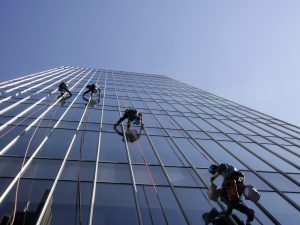Earlier this year, OSHA made headlines for the way it would revise the regulations regarding fall protection for general industry.
Did you know about the change?
As explained in the regulations by the department itself, the modification accounts for modernization of technology along with updates to old regulations.
It's important that building owners and managers understand the new developments. If you don't, you could be facing fines from the government - or worse, accidents at your property with increased legal liability.
There are several subtle changes in the regulations that have large implications. Specifically, the changes in fall protection for facade access and building maintenance could potentially be costly for building owners.
Here's what you need to know.
Standards for Window Washing & Exterior Maintenance
You're probably aware of the complicated protocol that already exists around suspended scaffolding systems.
Now, a few new rules have been tossed into the mix for General Industry. OSHA has basically adopted various ANSI, ASME, and IWCA standards that were loosely followed in the past. These are now law with clearly defined minimum requirements.
The most important change is the minimum load any rope descent (i.e. boatswain, bosun's chair, CDA, etc.) anchorage must now support. Prior to this update, a minimum of two to one safety factor was allowed (typically resulting in an anchor that could support around 1800 pounds). Now, ALL anchorages utilized in rope descent operations must be able to support a minimum of 5,000 pounds without permanent deformation.
Height standards are also changing for rope descent systems. No rope descent system can be anchored 300 feet above the base of a building barring some sort of extraordinary circumstance. Owners of buildings above this threshold will now have to accommodate the switch to powered platforms for window washing.
The ANSI/IWCA I-14 standard was widely considered the industry standard regarding anchorage testing and inspection. OSHA has now adopted the intent of this standard into the 1910.27 regulation. Building owners are now required to have their roof anchorages load tested upon installation, inspected annually, and load tested again every ten years.
The key takeaway from these changes is that OSHA is shifting much of the safety burden onto building owners and away from contractors. Building owners are now REQUIRED to provide written certification that their anchorages meet the new standards. Gone are the days where contractors could provide temporary anchorages to aid in window washing and exterior maintenance.
Deadlines for Implementation
The new regulations for rope descent can be costly as mentioned, but OSHA is not allowing much time for building owners to get up to speed. There are no “grandfather” type exceptions in the regulation, just a set deadline of November 20, 2017 to comply.
What does it mean if your building is not ready by then?
To put it simply, you will not be allowed to legally wash your windows or undergo exterior maintenance work until it is. There are options such as boom lifts for lucky building owners that have properties accessible from the ground, but any type of rope descent access that requires overhead suspension is not allowed.
Penalties for Accidents
There are no new fines that have been introduced as part of this new OSHA regulation overhaul. Keep in mind though that OSHA already approximately doubled fines towards the end of 2015.
Fines however, could be the least of one’s worries. As most building owners already know, potential legal damages in the event of a serious accident would far exceed any fines OSHA could levy. Throw a non-compliant building into the case, and the liability skyrockets.
A Good Thing?
Those who will face the immediate brunt of these costs will certainly disagree that this is good change in the short run. However, the new regulations have many benefits:
- Standardization of many loosely followed standards into one clear-cut law;
- Increased protection for workers. With permanent exterior maintenance systems now mandated, the potential for falls decreases;
- No more guessing – workers now know for certain whether the anchorages their lives depend on are safe for use;
- Long term savings in insurance risk premiums as accidents are mitigated.
Regardless if this OSHA update benefits you or not, it is important that you understand it like the back of your hand.
Update Your Facade Access System Now
Dirty windows can make for cranky tenants. The sun’s harmful UV rays continuously pound building exteriors. If you are unable to wash windows or provide exterior maintenance against weathering, your building is in trouble.
The team at DH Glabe & Associates has the expertise to get your building compliant in the most cost-effective manner possible.
Feel free to reach out to someone on our team today to learn how we can help you.









